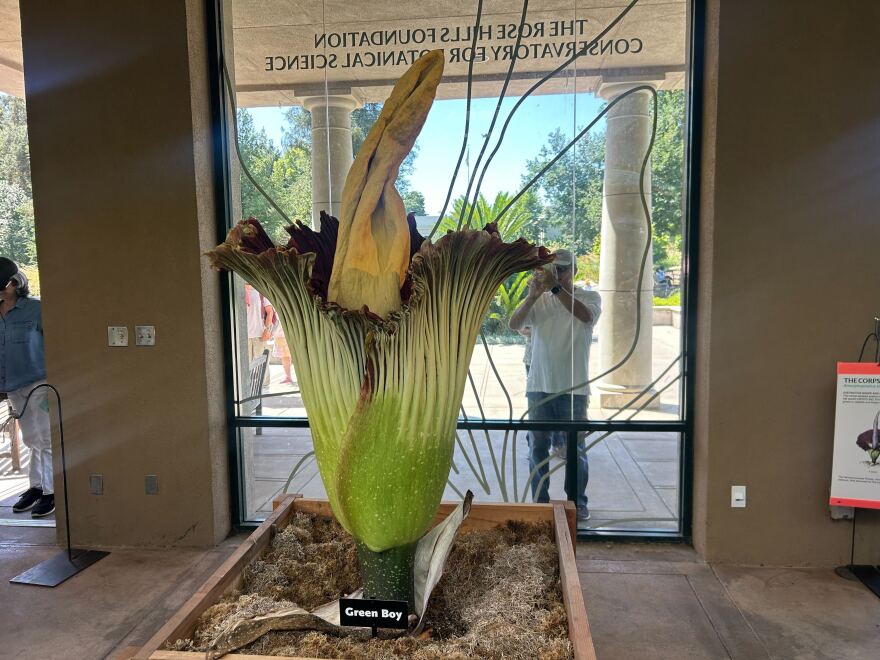Truth matters. Community matters. Your support makes both possible. LAist is one of the few places where news remains independent and free from political and corporate influence. Stand up for truth and for LAist. Make your year-end tax-deductible gift now.
The famously large corpse flower is in bloom at the Huntington. Beware the stench of rotting flesh

As the corpse flower blooms at the Huntington garden and museum in San Marino, officials expect to welcome at least 1,000 visitors hoping to see (and smell) the rare plant.
The endangered flower started to bloom Wednesday night and is expected to close back up by Thursday evening.
Corpse flowers blossom every four to six years. The specimen in bloom is called the Green Boy, and it last flowered in 2021.
The Huntington cares for 43 corpse flower plants, so officials say the public may not have to wait another handful of years to catch the next bloom.
What does it smell like?
Aside from being one of the largest flowers in the world, Amorphophallus titanum, or corpse flower, is most renowned for its not-so-pleasant smell.
Every plant is different. Corpse flowers have been described as smelling like rotten meat, sweaty gym socks, old cheese — you get the idea.
Devany Harden said she lives just 10 minutes from the Huntington, but has waited years to smell the corpse flower.
“It smells like just a rotten dumpster,” Harden said after taking her turn. “For sure, like death, and it is very pungent.”
Green Boy is starting to close, but at its tallest, it stood at about 5.8 feet.
Keisha Raines, communications specialist at the Huntington, said Green Boy is relatively tiny, but its smell is mighty.
“People say it smells like dirty laundry. People say that it smells exactly like a corpse,” Raines said. “To me, it smells like a compost bin that needs to be changed out.”
The stench is intended to attract nighttime pollinators such as flesh flies, carrion beetles and sweat bees.

Why is the flower endangered?
More corpse flowers exist today in conservatories than in the wild, said Brandon Tam, associate curator of orchids at the Huntington Botanical Gardens. “There's expected to be less than 300 left in the wild in Sumatra, Indonesia.”
The flowers are thought to have become endangered because of deforestation and climate change.
“There's many different varieties of reasons that can lead up to a decreasing population,” Tam said. “We don't know that for a fact because it's hard to get boots on the ground in a native habitat. It's harder to access, and the timing to be there while corpse flowers are in bloom is quite challenging.”
When can we see another bloom?
The Huntington has one of the largest collections of corpse flowers in North America. Most of the plants in the collection are descendants of a plant that bloomed in 2002, with possibly more on the way.
Since 1999, the Huntington has recorded 28 blooms.
“ We really sought to increase the frequency in which these corpse flowers will bloom for us, so that the general public doesn't have to wait once every four to six years,” Tam said. “But very likely, they would have to wait until the next summer to see the next bloom.”
The Huntington is open till 5 p.m. Thursday.











